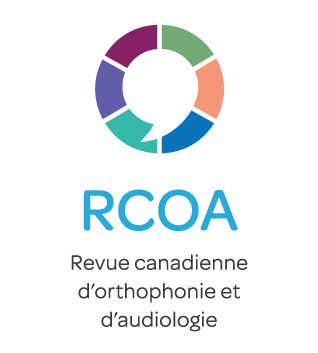

| Auteur(s) |
Lynn C. Brewster, MS Elizabeth Fitzpatrick, MSc |
| Volume | 19 |
| Numéro | 3 |
| Année | 1995 |
| Page(s) | 160-164 |
| Langue | Anglais |
| Catégorie | |
| Mots-clés |
cochlear implant habilitation profound hearing |
| Abrégé | This article provides a review of cochlear implant services for children in Canada. Currently there are nine paediatric cochlear implant centres, seven of which provide cochlear implant surgery. The results of the survey completed in December, 1994 are presented. Information related to candidacy, nember of children implanted, expectations, and habilitation services are reported. Coclear implants have become accepted as a viable option for children who have profound hearing loss and who derive little benefit from conventional amplification (Canadian Association of Speech Language Pathologists and Audiologists Position Paper, 1995). In June 1990, the United States Food and Drug Administration approved the use of the Nucleus-22 channel cochlear implant sevice with children. Since then, the number of children implanted worldwide has increased dramatically. In Canada, cochlear implants have been used in adults and children since the 1980's. The availablity of implants and program funding have varied widely from province to province. Currently, the majority of cochlear implant programs are funded entirely or partially by provincial governments. There are currently seven hospitals performing coclear implant surgery in children in Canada. Two other implant programs carry out pre- and post- implant intervention, but do not include a surgery component. The purpose of this article is to describe some of the services offered by these programs and to provide some of the demographics for choldren in Canada who have received cochlear implants. |
| ID | 210 |
| Lien | https://cjslpa.ca/files/1995_JSLPA_Vol_19/No_03_141-212/Brewster_Fitzpatrick_JSLPA_1995.pdf |
La RCOA est une revue en accès libre, ce qui signifie que tous les articles sont disponibles sur Internet dès leur publication, et ce, pour tous les utilisateurs. Les utilisateurs sont autorisés à lire, télécharger, copier, distribuer, imprimer, rechercher ou fournir le lien vers le contenu intégral des articles, ou encore, à utiliser les articles à toutes autres fins légales.
La RCOA ne charge aucun frais pour le traitement ou la publication des manuscrits.
C’est l’Orthophonie et Audiologie Canada (OAC) qui détient les droits d’auteur de la Revue canadienne d’orthophonie et d’audiologie. Il faut mentionner la source (OAC, nom de la publication, titre de l’article, numéro du volume, numéro de la parution et numéro des pages), mais sans laisser entendre que OAC vous approuve ou approuve l’utilisation que vous faites du texte. Il est interdit d’utiliser les documents à des fins commerciales. Il est interdit de modifier, transformer ou développer le texte.